Related Research Articles

The Battle of Crete, codenamed Operation Mercury, was a major Axis airborne and amphibious operation during World War II to capture the island of Crete. It began on the morning of 20 May 1941, with multiple German airborne landings on Crete. Greek and other Allied forces, along with Cretan civilians, defended the island. After only one day of fighting, the Germans had suffered heavy casualties and the Allied troops were confident that they would defeat the invasion. The next day, through communication failures, Allied tactical hesitation, and German offensive operations, Maleme Airfield in western Crete fell, enabling the Germans to land reinforcements and overwhelm the defensive positions on the north of the island. Allied forces withdrew to the south coast. More than half were evacuated by the British Royal Navy and the remainder surrendered or joined the Cretan resistance. The defence of Crete evolved into a costly naval engagement; by the end of the campaign the Royal Navy's eastern Mediterranean strength had been reduced to only two battleships and three cruisers.
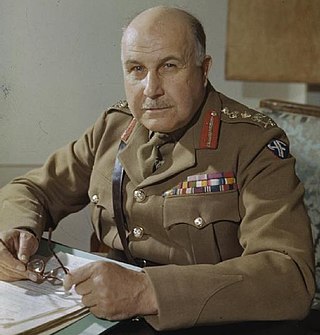
Field Marshal Henry Maitland Wilson, 1st Baron Wilson,, also known as Jumbo Wilson, was a senior British Army officer of the 20th century. He saw active service in the Second Boer War and then during the First World War on the Somme and at Passchendaele. During the Second World War he served as General Officer Commanding-in-Chief (GOC-in-C) British Troops in Egypt, in which role he launched Operation Compass, attacking Italian forces with considerable success, in December 1940. He went on to be Military Governor of Cyrenaica in February 1941, commanding a Commonwealth expeditionary force to Greece in April 1941 and General Officer Commanding (GOC) British Forces in Palestine and Trans-Jordan in May 1941.
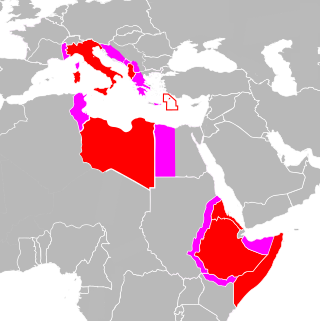
The participation of Italy in the Second World War was characterized by a complex framework of ideology, politics, and diplomacy, while its military actions were often heavily influenced by external factors. Italy joined the war as one of the Axis Powers in 1940 with a plan to concentrate Italian forces on a major offensive against the British Empire in Africa and the Middle East, known as the "parallel war", while expecting the collapse of British forces in the European theatre. The Italians bombed Mandatory Palestine, invaded Egypt and occupied British Somaliland with initial success. However, the British counterattacked, eventually necessitating German support to prevent an Italian collapse in North Africa. As the war carried on and German and Japanese actions in 1941 led to the entry of the Soviet Union and United States, respectively, into the war, the Italian plan of forcing Britain to agree to a negotiated peace settlement was foiled.
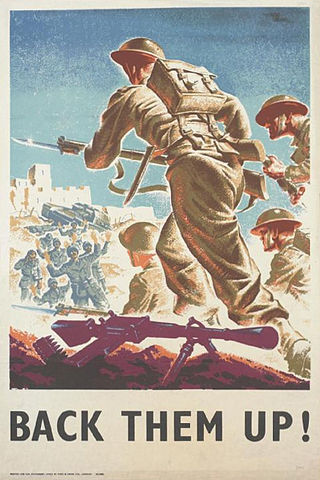
The military history of the United Kingdom in World War II covers the Second World War against the Axis powers, starting on 3 September 1939 with the declaration of war by the United Kingdom and France, followed by the UK's Dominions, Crown colonies and protectorates on Nazi Germany in response to the invasion of Poland by Germany. There was little, however, the Anglo-French alliance could do or did do to help Poland. The Phoney War culminated in April 1940 with the German invasion of Denmark and Norway. Winston Churchill became prime minister and head of a coalition government in May 1940. The defeat of other European countries followed – Belgium, the Netherlands, Luxembourg and France – alongside the British Expeditionary Force which led to the Dunkirk evacuation in June 1940.

Operation Sonnenblume was the name given to the dispatch of German and Italian troops to North Africa in February 1941, during the Second World War. The Italian 10th Army had been destroyed by the British, Commonwealth, Empire and Allied Western Desert Force attacks during Operation Compass (9 December 1940 – 9 February 1941). The first units of the new Deutsches Afrikakorps (DAK), commanded by Generalleutnant Erwin Rommel, departed Naples for Africa and arrived on 11 February 1941. On 14 February, advanced units of the 5th Light Afrika Division, Aufklärungsbataillon 3 and Panzerjägerabteilung 39 arrived at the Libyan port of Tripoli and were sent immediately to the front line east of Sirte.

The North African campaign of the Second World War took place in North Africa from 10 June 1940 to 13 May 1943. It included campaigns fought in the Libyan and Egyptian deserts and in Morocco and Algeria, as well as Tunisia. The campaign was fought between the Allies and the Axis Powers. The Allied war effort was dominated by the British Commonwealth and exiles from German-occupied Europe. The United States officially entered the war in December 1941 and began direct military assistance in North Africa on 11 May 1942.
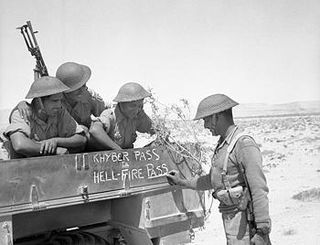
Operation Battleaxe was a British Army offensive during the Second World War to raise the Siege of Tobruk and re-capture eastern Cyrenaica from German and Italian forces. It was the first time during the war that a significant German force fought on the defensive. The British lost over half of their tanks on the first day and only one of three attacks succeeded.

The Balkans campaign of World War II began with the Italian invasion of Greece on 28 October 1940. In the early months of 1941, Italy's offensive had stalled and a Greek counter-offensive pushed into Albania. Germany sought to aid Italy by deploying troops to Romania and Bulgaria and attacking Greece from the east. Meanwhile, the British landed troops and aircraft to shore up Greek defences. A coup d'état in Yugoslavia on 27 March caused Adolf Hitler to order the conquest of that country.

The Western Desert campaign took place in the deserts of Egypt and Libya and was the main theatre in the North African campaign of the Second World War. Military operations began in June 1940 with the Italian declaration of war and the Italian invasion of Egypt from Libya in September. Operation Compass, a five-day raid by the British in December 1940, was so successful that it led to the destruction of the Italian 10th Army over the following two months. Benito Mussolini sought help from Adolf Hitler, who sent a small German force to Tripoli under Directive 22. The Afrika Korps was formally under Italian command, as Italy was the main Axis power in the Mediterranean and North Africa.

Operation Brevity was a limited offensive conducted in mid-May 1941, during the Western Desert Campaign of the Second World War. Conceived by the commander-in-chief of the British Middle East Command, General Archibald Wavell, Brevity was intended to be a rapid blow against weak Axis front-line forces in the Sollum–Capuzzo–Bardia area of the border between Egypt and Libya. Although the operation got off to a promising start, throwing the Axis high command into confusion, most of its early gains were lost to local counter-attacks, and with German reinforcements being rushed to the front the operation was called off after one day.

The German invasion of Greece, also known as the Battle of Greece or Operation Marita, was the attacks on Greece by Italy and Germany during World War II. The Italian invasion in October 1940, which is usually known as the Greco-Italian War, was followed by the German invasion in April 1941. German landings on the island of Crete came after Allied forces had been defeated in mainland Greece. These battles were part of the greater Balkans Campaign of the Axis powers and their associates.

The Anglo-Iraqi War was a British-led Allied military campaign during the Second World War against the Kingdom of Iraq under Rashid Gaylani, who had seized power in the 1941 Iraqi coup d'état with assistance from Germany and Italy. The campaign resulted in the downfall of Gaylani's government, the re-occupation of Iraq by the British, and the return to power of the Regent of Iraq, Prince 'Abd al-Ilah, a British ally.

The Syria–Lebanon campaign, also known as Operation Exporter, was the invasion of Syria and Lebanon in June and July 1941 by British Empire forces, during the Second World War.

The Mediterranean and Middle East Theatre was a major theatre of operations during the Second World War. The vast size of the Mediterranean and Middle East theatre saw interconnected naval, land, and air campaigns fought for control of the Mediterranean, North Africa, the Horn of Africa, the Middle East and Southern Europe. The fighting lasted from 10 June 1940, when Italy entered the war on the side of Germany, until 2 May 1945 when all Axis forces in Italy surrendered. However, fighting would continue in Greece – where British troops had been dispatched to aid the Greek government – during the early stages of the Greek Civil War.

The military history of Greece during World War II began on 28 October 1940, when the Italian Army invaded Greece from Albania, beginning the Greco-Italian War. The Greek Army temporarily halted the invasion and pushed the Italians back into Albania. The Greek successes forced Nazi Germany to intervene. The Germans invaded Greece and Yugoslavia on 6 April 1941, and overran both countries within a month, despite British aid to Greece in the form of an expeditionary corps. The conquest of Greece was completed in May with the capture of Crete from the air, although the Fallschirmjäger suffered such extensive casualties in this operation that the Oberkommando der Wehrmacht abandoned large-scale airborne operations for the remainder of the war. The German diversion of resources in the Balkans is also considered by some historians to have delayed the launch of the invasion of the Soviet Union by a critical month, which proved disastrous when the German Army failed to take Moscow.

The Allied leaders of World War II listed below comprise the important political and military figures who fought for or supported the Allies during World War II. Engaged in total war, they had to adapt to new types of modern warfare, on the military, psychological and economic fronts.
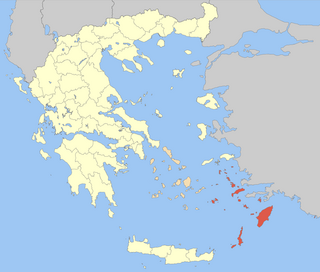
The Dodecanese campaign of World War II was an attempt by Allied forces to capture the Italian Dodecanese islands in the Aegean Sea following the Armistice with Italy in September 1943, and use them as bases against the German-controlled Balkans. Operating without air cover, the Allied effort was a costly failure, the whole of the Dodecanese falling to the Germans within two months. The Dodecanese campaign, lasting from 8 September to 22 November 1943, resulted in one of the last major German victories in the war.

The Battle of Heraklion was part of the Battle of Crete, fought during World War II on the Greek island of Crete between 20 and 30 May 1941. British, Australian and Greek forces of 14th Infantry Brigade, commanded by Brigadier Brian Chappel, defended Heraklion port and airfield against a German paratrooper attack by the 1st Parachute Regiment of the 7th Air Division, commanded by Colonel Bruno Bräuer.

During the German invasion of Greece on 6 April 1941, the Allied forces were pushed back from Macedonia and Thessaly into mainland Greece while the British fleet stood by at various ports in the south of Greece to evacuate any remaining Allied troops from the advancing German ground and air units. A critical target during the German invasion, was the Corinth Canal which divided the Peloponnesus from the Greek mainland as Hitler saw it as the gateway to control the Aegean Sea and trap the evacuating Allied forces in Greece if it were captured and kept operational.

The German invasion of Greece on 6 April 1941, had already been anticipated by the Allied forces. So a defense line was created across the mountain passes near Mount Olympus consisting of British, Australian and New Zealand troops which would prevend the German forces from capturing Thessaly and thereby denying them the opportunity to advance into mainland Greece. However, the speed of the German invasion force had made sure that the endurance of the defending troops and the strength of their defences were very quickly going to be put to the test.
References
- Beckett, Ian (1991). "Wavell". In Keegan, John (ed.). Churchill's Generals. London: Cassell. ISBN 0-304-36712-5.
- Crabb, Brian James (2021). Operation Demon. The story of the evacuation of British Commonwealth troops from mainland Greece and the tragic loss of the Dutch troopship Slamat and HM destroyers Diamond and Wryneck in April 1941. Angela Young. Portishead, Bristol. ISBN 978-1-527271-01-2.
- O'Hara, Vincent (2009). Struggle for the Middle Sea. Naval Institute Press. ISBN 978-1612514086.
- Playfair, Major-General I. S. O.; with Flynn R.N., Captain F. C.; Molony, Brigadier C. J. C. & Toomer, Air Vice-Marshal S. E. (2004) [1st HMSO 1956]. Butler, J. R. M. (ed.). The Mediterranean and Middle East: The Germans come to the help of their Ally (1941). History of the Second World War, United Kingdom Military Series. Vol. II. Naval & Military Press. ISBN 1-84574-066-1.
- Crawford, John, ed. (2000). Kia Kaha: New Zealand in the Second World War. Auckland, NZ: Oxford. ISBN 9780195584554.